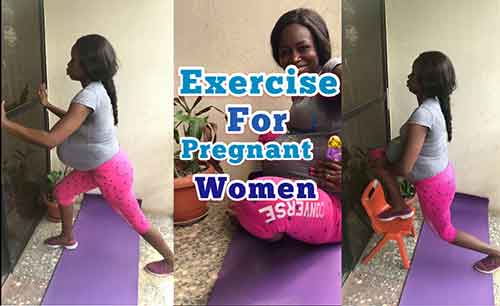One of the very things some pregnant women avoid is exercise or physical activity.
Sadly some of them continue with the assumption that a pregnant woman does not need to exercise.
Well, pregnancy is not a sentence to sedentary behaviour or a life fraught with low level of physical activity.
An adequate flow of blood to all organs of the body is at all times very beneficial to everyone.
We understand that some ladies could lose pregnancy by just jumping or doing some strenuous exercises.
But we are not asking you to jump or engage in some difficult workouts like someone preparing for a competition. All we are sharing here is the cat and that is; every regnant woman needs an amount of exercise for a healthy pregnancy period.
We will also go ahead to share what types of exercise or workout a pregnant woman can engage in through her pregnancy period.
In fact, experts at the World health Organization (WHO) are particular about this necessary exercise or physical activity during pregnancy and after (1).
According to the WHO, physical activity confers these maternal and fetal health benefits:
- Decreased risk of pre-eclampsia
- Gestational hypertension
- Gestational diabetes
- Excessive gestational weight gain
- Delivery complications and postpartum depression
- Fewer newborn complications,
To douse your fears of miscarriage occurring, experts say physical activity during pregnancy and after birth has no adverse effects on birthweight.
Also, it does not increase risk of stillbirth.
Recommended Types Of Exercise For Pregnant And Postpartum Women
WHO recommends that pregnant or postpartum women should start by doing small amounts of physical activity.
They should then gradually increase frequency, intensity and duration over time.
Do not begin exercising with tough physical activities when you have not been doing those before.
You can engage in pelvic floor muscle training on a daily basis. This form of exercise helps reduce the risk of urinary incontinence.
Amount Of Exercise Minutes Pregnant Women Need
Most importantly, engage in at least 150 minutes of moderate intensity aerobic physical activity throughout the week for substantial health benefits.
Incorporate a variety of aerobic and muscle strengthening activities. Also, it will be great to add gentle stretching. This is very beneficial.
When Not To Exercise As A Pregnant Woman
A pregnant woman should avoid physical activity during excessive heat, especially with high humidity.
Also avoid participating in activities which involve physical contact that poses a high risk of falling.
It is important that you also avoid engaging in activities that might limit oxygenation (such as activities at high altitude, when not normally living at high altitude).
After first trimester of pregnancy, avoid activities in supine position.
Furthermore, experts recommend that you stay hydrated by drinking water before, during, and after
physical activity.
Have You Read: Alligator Pepper As Contraceptive: See What We Found
It is also important that you seek supervision from a specialist health-care provider when considering athletic competition, or exercising significantly above the recommended guidelines.
Other recommendations are that pregnant women should seek information from their health-care provider concerning the danger signs that could require that they stop exercising.
Also, in pregnant and postpartum women, as in all adults, sedentary behaviour is highly discouraged.
Sedentary behaviour during pregnancy is associated with the following poor health outcomes:
- All-cause mortality
- Cardiovascular disease mortality
- Cancer mortality
- Incidence of cardiovascular disease
- Cancer and
- Incidence of type-2 diabetes.
Finally, after delivery, it is important that you return to physical activity gradually and in consultation with a health-care provider, in the case of delivery by Caesarean section.



